Few houseplants are as striking and mesmerizing as calatheas. With their dramatic foliage—patterned in purples, pinks, silvers, and greens—these tropical beauties are often referred to as “prayer plants,” thanks to the way their leaves fold upward at night as if in prayer. While undeniably gorgeous, calatheas are also known for being a little fussy indoors, leading many plant lovers to struggle with crispy edges, drooping leaves, or dull color.
The good news? With the right knowledge, you can keep your calathea not only alive but thriving, showing off its full vibrancy year-round. This guide will walk you through everything you need to know—from light and humidity to soil and troubleshooting—so you can enjoy lush, healthy foliage that truly turns heads.
Why Calatheas Are Worth the Effort
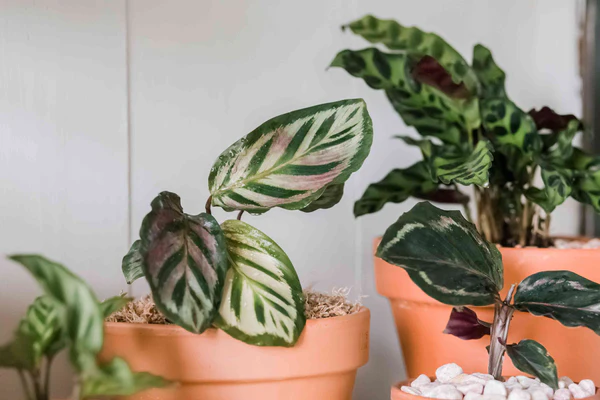
Calatheas (members of the Marantaceae family) are native to tropical rainforests in South America, where they grow under tree canopies in warm, humid, shaded environments. Their natural habitat explains why they demand a little extra care indoors. But they reward that care in unique ways:
- Show-stopping foliage: From the zebra-striped Calathea zebrina to the pink and green Calathea roseopicta, no two varieties are quite alike.
- Non-toxic to pets: Unlike many houseplants, calatheas are safe for cats and dogs.
- Air-purifying: They help filter indoor air and add fresh oxygen.
- Dynamic beauty: Their rhythmic leaf movement (nyctinasty) adds life and movement to your indoor space.
If you want a houseplant that feels more like living art, calatheas are a perfect choice.
Light: Bright but Indirect
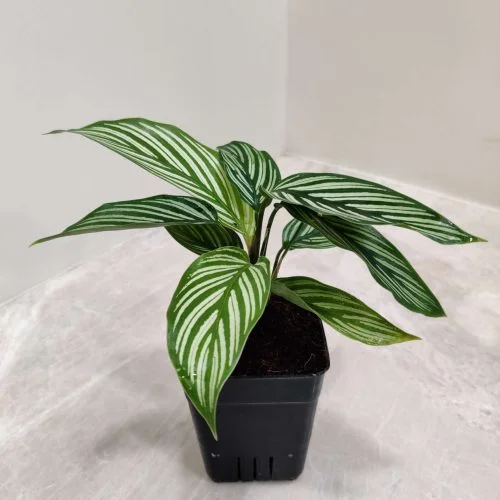
The biggest mistake people make with calatheas is giving them too much sun. These plants evolved under dense canopies, which means they thrive in bright, indirect light—never harsh, direct rays.
- Best location: Place near an east- or north-facing window. A sheer curtain over a south or west-facing window can also work.
- Too much sun? Yellowing leaves or faded patterns usually mean it’s getting scorched.
- Too little light? Leaves may curl, droop, or growth may slow dramatically.
If natural light is limited, a full-spectrum grow light set on a 10–12-hour cycle will keep your calathea healthy.
Temperature and Humidity: Mimic the Tropics
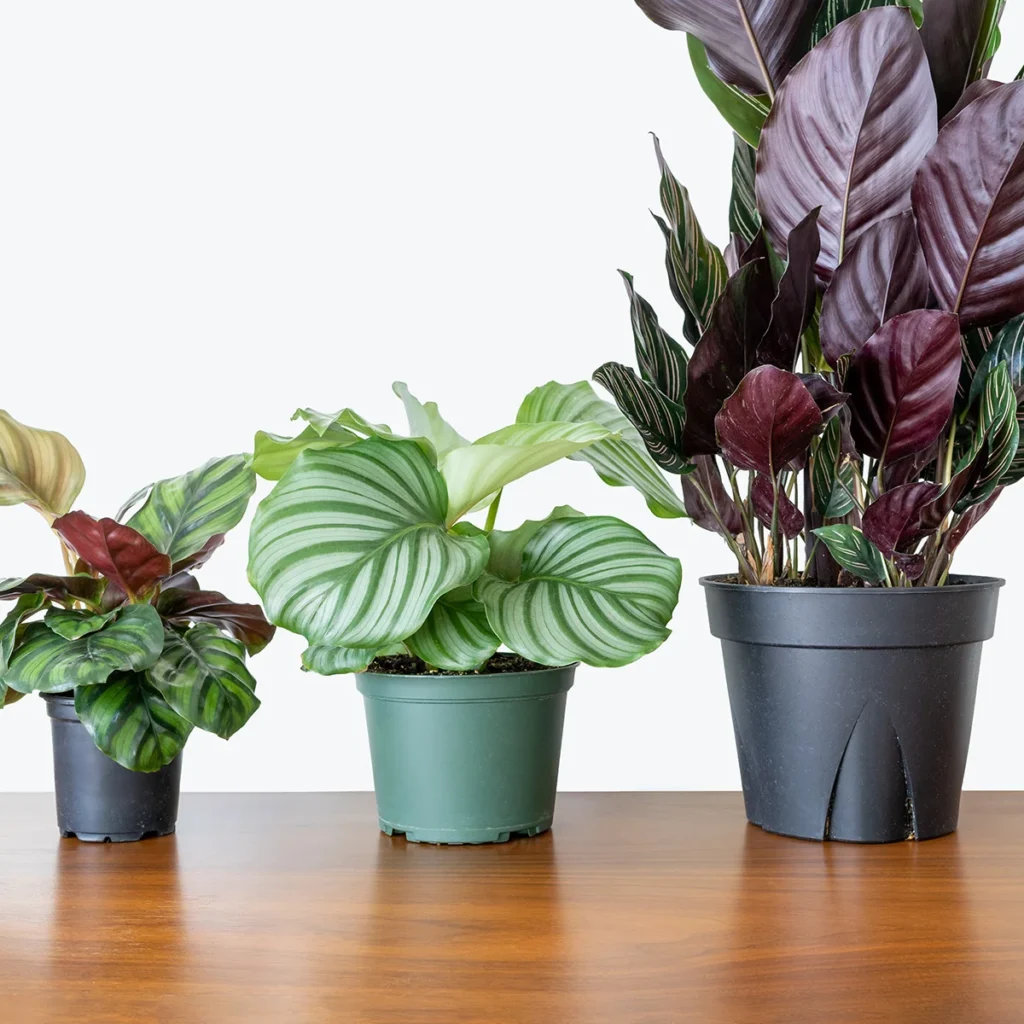
Calatheas are warmth-loving plants that detest drafts, sudden temperature swings, or dry air.
- Temperature range: Aim for 65–80°F (18–27°C). Avoid anything below 60°F (15°C).
- Humidity: The number one secret to vibrant leaves is high humidity—50% or more. Indoors, especially in winter, humidity can drop drastically, causing crispy edges.
Ways to boost humidity:
- Use a humidifier near your plant.
- Place the pot on a pebble tray filled with water.
- Group calatheas with other tropical plants to create a microclimate.
- Mist occasionally, but avoid leaving water droplets on the leaves, which can encourage fungal issues.
Soil and Potting
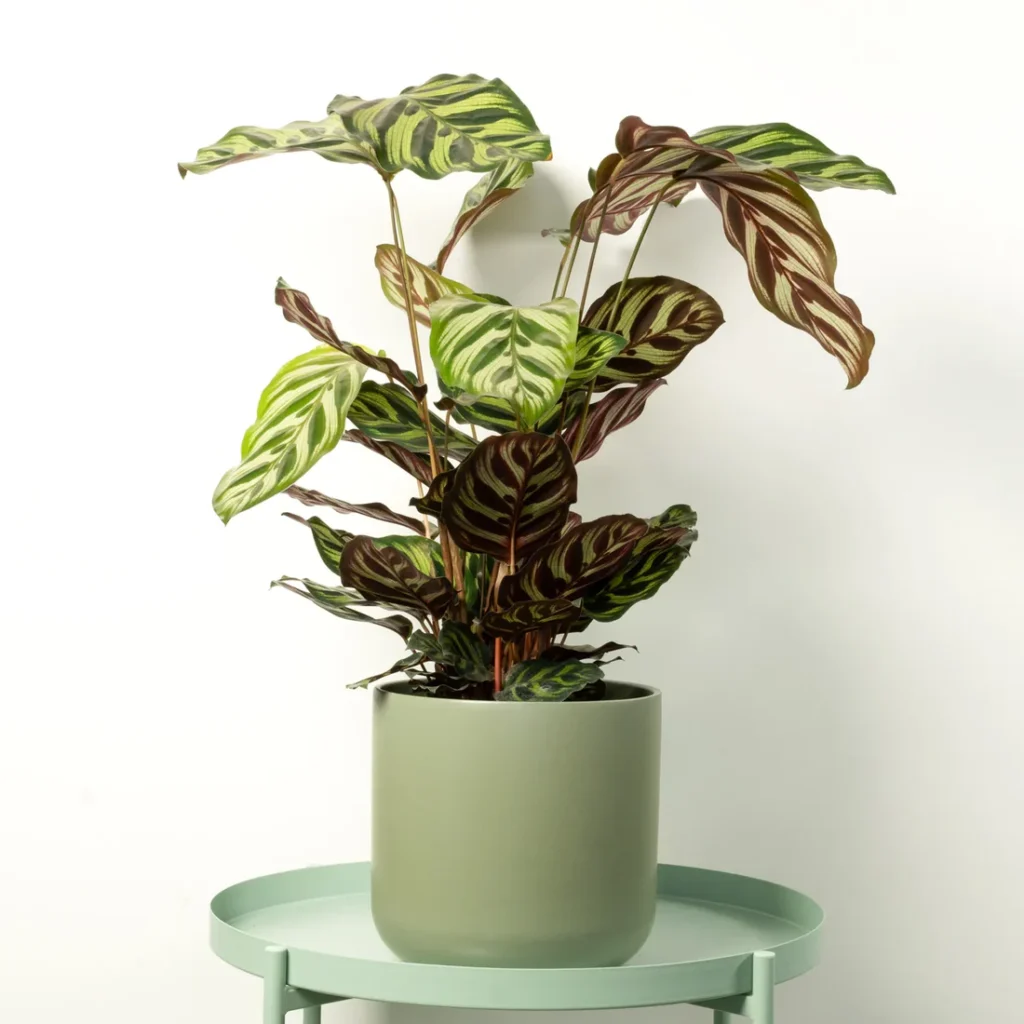
Calatheas need soil that holds some moisture but drains well—similar to the forest floor of their native environment.
- Best soil mix: Combine 2 parts peat or coco coir, 1 part perlite, and 1 part orchid bark. This ensures moisture retention with good aeration.
- Pot type: Choose a pot with good drainage holes to prevent root rot. Terracotta pots can dry out too quickly, so glazed ceramic or plastic pots often work better.
- Repotting: Every 1–2 years in spring is ideal, as calatheas don’t like being rootbound. Refreshing the soil also prevents compaction.
Watering: Keep It Consistent
Calatheas are sensitive when it comes to watering. Too little, and leaves curl; too much, and roots suffocate. The key is consistency.
- When to water: Check the top inch of soil—if it feels slightly dry, it’s time to water. Don’t wait until the soil is bone-dry.
- Water type matters: Tap water with high chlorine, fluoride, or salts often causes brown leaf tips. Calatheas do best with filtered, rain, or distilled water.
- Method: Water thoroughly until water drains from the bottom, then empty the saucer. Never let the plant sit in standing water.
Tip: If you see crispy edges despite proper humidity, your water quality may be to blame.
Fertilizing Calatheas
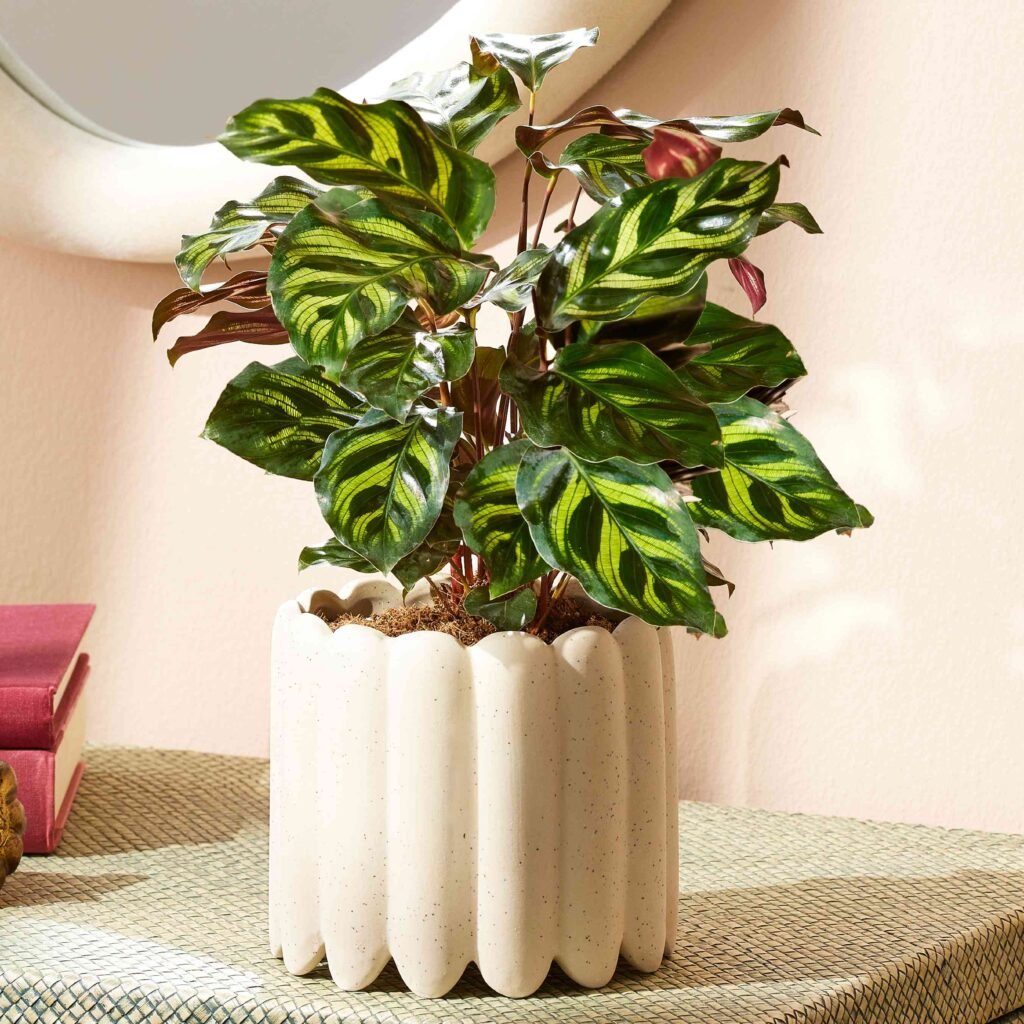
While not heavy feeders, calatheas appreciate occasional nutrients to maintain lush leaves.
- Type: Use a balanced, water-soluble fertilizer diluted to half-strength.
- Frequency: Feed once a month during the growing season (spring and summer).
- Rest period: Stop fertilizing in fall and winter when growth naturally slows.
Over-fertilizing can lead to burned roots and dull leaf colors—less is more here.
Pruning and Grooming
Calatheas aren’t fast growers, but routine grooming keeps them looking vibrant.
- Trim off yellowed or brown leaves with clean scissors at the base.
- Wipe leaves regularly with a damp cloth to remove dust and allow them to “breathe.”
- Rotate the pot every couple of weeks to encourage even growth.
Pruning encourages energy to go into new, healthy foliage.
Common Calathea Problems and Fixes
Even with good care, calatheas sometimes signal distress through their leaves. Here’s how to troubleshoot:
- Crispy brown edges
- Likely cause: Low humidity or poor-quality water.
- Fix: Increase humidity and switch to filtered or distilled water.
- Curling leaves
- Likely cause: Underwatering or too much direct sun.
- Fix: Adjust watering schedule and move to a shadier spot.
- Yellowing leaves
- Likely cause: Overwatering or poor drainage.
- Fix: Allow soil to dry slightly and check for root rot.
- Drooping leaves
- Likely cause: Stress from temperature changes or underwatering.
- Fix: Stabilize environment and water consistently.
- Pest infestations (spider mites, aphids, thrips)
- Calatheas can attract pests in dry conditions.
- Fix: Increase humidity and treat with neem oil or insecticidal soap.
Propagating Calatheas
Unlike some plants, calatheas aren’t easily propagated from cuttings. Instead, they spread by rhizomes, which can be divided.
- Best time: During repotting in spring.
- Method: Gently separate the root ball into smaller clumps, ensuring each section has roots and leaves.
- Pot each division into fresh soil and keep in a warm, humid environment until established.
Popular Calathea Varieties for Indoors
If you’re starting or expanding your collection, here are some of the most loved varieties:
- Calathea orbifolia: Large, round leaves with silver stripes.
- Calathea zebrina: Striking zebra-like striping.
- Calathea roseopicta: Green leaves with pink or white patterns.
- Calathea lancifolia (Rattlesnake Plant): Long, narrow leaves with wavy edges and dark spots.
- Calathea makoyana (Peacock Plant): Stunning feather-like leaf patterns.
Each variety has similar care requirements but brings unique beauty to your indoor jungle.
Seasonal Care Adjustments
Calatheas’ needs shift slightly with the seasons:
- Spring & Summer: Active growth phase. Water more often, fertilize monthly, and keep humidity high.
- Fall & Winter: Growth slows. Reduce watering frequency and stop fertilizing. Watch out for dry air from indoor heating.
Maintaining consistency is key during seasonal changes.
Final Thoughts
Calatheas may be labeled “divas” of the plant world, but with the right care, they reward you with some of the most spectacular foliage you’ll ever see indoors. The secret lies in mimicking their natural rainforest habitat: bright but indirect light, consistent moisture, warm temperatures, and above all—high humidity.
If you’ve struggled with calatheas before, don’t be discouraged. Start fresh with the right soil, water, and environment, and you’ll soon see why these plants are such beloved indoor favorites. Their lush, patterned leaves not only bring vibrancy to your home but also a daily reminder of the beauty of nature’s design.
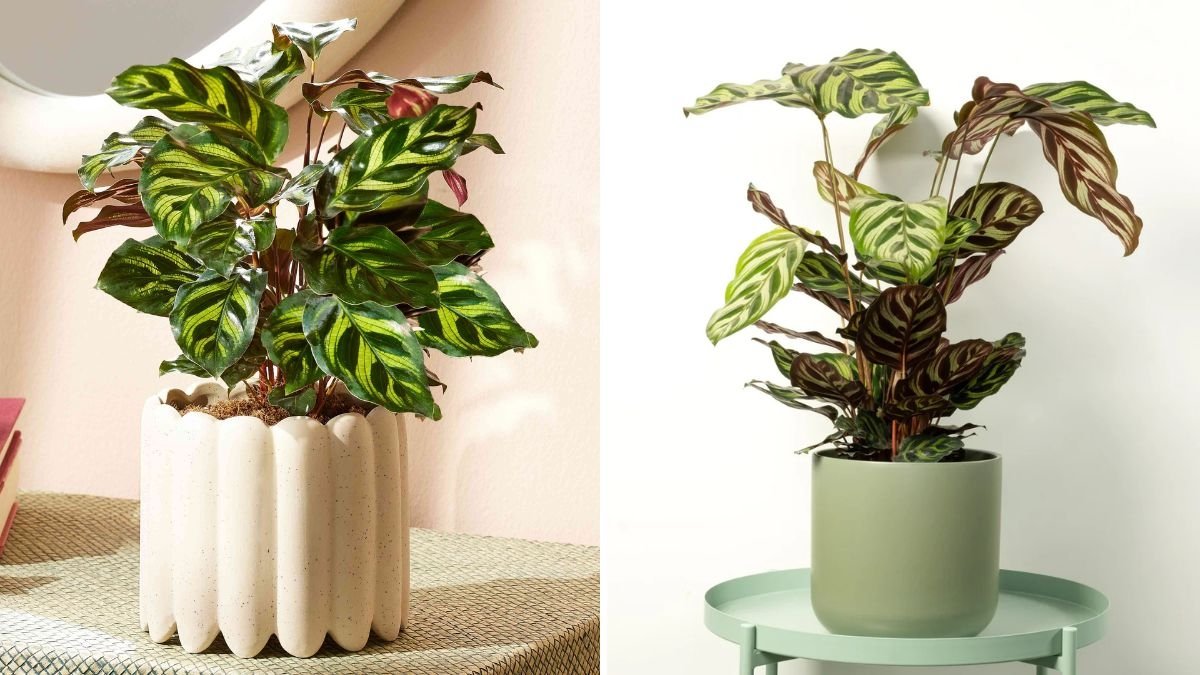




Leave A Comment